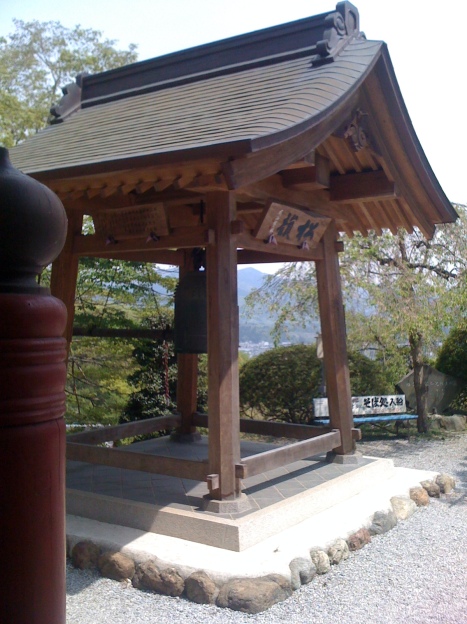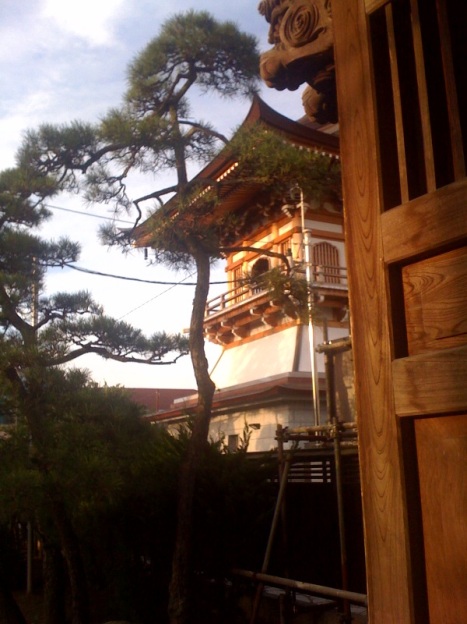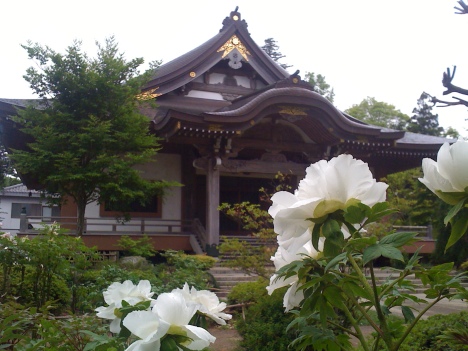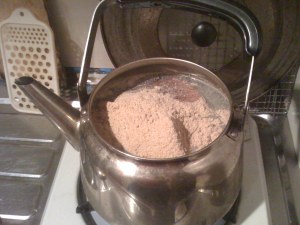This week is Golden Week in Japan, the series of consecutive national holidays that commemorate the Showa Emperor’s reign, Children’s Day and Greenery Day.
On Monday, I got itchy feet. This holiday presents an opportunity for an extended holiday, but everybody is on the road or packing the trains, so I had decided not to go anywhere to avoid the crowds. Monday evening, I got on my bike and rambled out to Matsudo to discover a good route to 21st Century Park, a big draw there. On the way back in the dark, I thought, I really ought to get farther away, into the mountains or down to the beach, no matter the crowds.
So, we headed out just after 6am on Tuesday morning for Chichibu, the mountainous region of Saitama Prefecture. The JR trains were not terribly crowded, but when we had to stand on the Seibu Railway trains on the way from Hanno to Chichibu. The trains were packed with families in full mountaineering gear – hiking poles, over-engineered sports wear, packing huge bags. Were they all going the same way? As we got deeper into the mountains, parties got off the trains and hit the trails into the mountains. Were we missing something?
JNTO provides some good maps of Chichibu and Okutama, which I had studied up on. But I couldn’t find any good travel information on tea houses, temple histories or the like. It’s meager in English.
At Chichibu Station, we got a wad of maps, almost all in Japanese, and chose a four-hour walking route on the west side of the Arakawa River. On our route were a number of temples which belong to the 秩父三十四観音霊場 Chichibu 34 Kannon Reijo, the 34 temples dedicated to Kannon that comprise one third of the big pilgrimage of 100 temples that, if completed in the proper order, save the pilgrim from hell.
On the route, starting from Chich ibu Station we encountered temple #16, Saikouji, a Shingon Buddhist temple which has a u-shaped hall containing statues of Buddhas and deities representing the 88 temples of the Shikoku pilgrimage. Each of the temples are indicated by ancient markers and more modern municipal sign posts. Curiously, we found the old signs and stones more reliable than the flashy new brass-adorned cedar posts.
ibu Station we encountered temple #16, Saikouji, a Shingon Buddhist temple which has a u-shaped hall containing statues of Buddhas and deities representing the 88 temples of the Shikoku pilgrimage. Each of the temples are indicated by ancient markers and more modern municipal sign posts. Curiously, we found the old signs and stones more reliable than the flashy new brass-adorned cedar posts.
Our next stop took us across the Harp Bridge over the Arakawa to some picturesque hillside farms, where we made the mistake of following the new signposts, wandered through farm pastures and gardens, rejoined our path at a road-side tea house, gorged on strawberries, greeted the goats and rabbits, and made our way down to temple #22, Dojido, with a gate flanked by the wind and thunder gods.
There the wind was strong enough that it took several attempts to light insense to put in the big burner in front of the temple.
At the gate, an enormous cherry tree was still blooming.  After Dojido, we followed a narrow path past farm fields, rice paddies, a cemetery, over the main road, and back into the maze of gardens that we had rambled through by accident.
After Dojido, we followed a narrow path past farm fields, rice paddies, a cemetery, over the main road, and back into the maze of gardens that we had rambled through by accident.
Our next goal was Ongakuji, #23, which overlooks the valley and has a great bell. We wandered between farm houses, up steep hillsides through cedar forests, and were surprised when the trail ran out and left us standing in some farmer’s front garden.
Just when we thought we had lost the path, I spotted an animal in the road, bigger than a cat, gray coated and wiry looking. A fox! The fox startled, and pelted down a hilside trail. When I saw the head of the trail, I realized this was the route. The fox is a messenger of Oinari, the god of rice and all industry.
We saw

the
view from Ongakuji, watered, and took in the atmosphere. Some streamers of origimi balloons hung on the temple door.
 From the veranda of the temple, we could see the valley and hear the uguisu birds in the trees, and heard some drumming and fireworks in the distance. Far below, children were playing in the Arakawa River, and we could hear their screams and laughter because of the breeze blowing off the river.
From the veranda of the temple, we could see the valley and hear the uguisu birds in the trees, and heard some drumming and fireworks in the distance. Far below, children were playing in the Arakawa River, and we could hear their screams and laughter because of the breeze blowing off the river.
We drank water, wandered through a park, rejoined the pilgrim path, and clambered over streams, through bamboo thickets and meadows and got thoroughly lost again.
We spotted a sign on the road, a yakiniku shop called “Yahei”. In the mid afternoon, we were the only customers, and enjoyed some grilled pork, kimchi and umeboshi.
The hostess drew us a simple map to indicate how to get to #24 and #25. After our meal, she pointed us in the right direction and again, we were surprised by the winding trails that again took us through gardens and farm fields. We lost the thread but made it to #24, Hosenji, a Rinzai sect temple at the top of a tall set of stairs.
In front of the offertory box, two middle-aged men in bicycle tights were praying. I hung back and rested a bit on a bench until they were done.
As I made my offering, they asked me how long I had been in Japan and why I came here. I blurted out, “To learn about Buddhism and the martial way.” One of them said, “Oh, you mean like ninja, at that school in Noda City, right?” I was taken aback. So few Japanese people know anything about the Bujinkan martial arts. It was actually refreshing to meet Japanese who know about this. I told them I’m on break, and getting out to discover more about Japan. Hence, coming to Chichibu. They turned out to be local guys from the valley.
Everywhere, we saw flowers, but many are not native. The most common is the 芝 桜, which literally means grass cherry. In English, it’s flox, which originates from America. The image many people have of Chichibu is of the vast field of shibazakura at Hitsujiyama Park near the train station. I ran my hand over some flox growing above a rock wall and was surprised at the feathery texture of the flowers. I’m growing some in my garden here in Kashiwa. We spotted iceplant, too, a hardy African plant that also has bright pink blossoms. No matter that these plants were as alien as I am to this landscape. They were pretty.
桜, which literally means grass cherry. In English, it’s flox, which originates from America. The image many people have of Chichibu is of the vast field of shibazakura at Hitsujiyama Park near the train station. I ran my hand over some flox growing above a rock wall and was surprised at the feathery texture of the flowers. I’m growing some in my garden here in Kashiwa. We spotted iceplant, too, a hardy African plant that also has bright pink blossoms. No matter that these plants were as alien as I am to this landscape. They were pretty.
Our last stop was #25, a temple that was looking a little rough. The wall to the east of the temple was covered in fresh concrete, and a new road skirted the front gate. The temple itself was listing and visibly sideways. It appears that the land is not stable under the ancient temple.
Two painters were working under a pine tree, making the most of the late afternoon sun shining through the forest behind the temple. The front of the temple is covered in pilgrim’s name stickers documenting their visits. The sound of trickling water and bird song was all I could hear. Total peace and a respite from Tokyo hell for a day.
Filed under: Buddhism, culture, travel, Uncategorized | Leave a comment »
 Manmanji, orginally called Dainichiji when it was built in 1226, is a Rinzai sect temple in Matsudo City. it’s a short walk from the east exit of Mabashi Station on the Joban Line. The temple is notable for Muromachi Period statuary including the two great Deva Kings at the gate.
Manmanji, orginally called Dainichiji when it was built in 1226, is a Rinzai sect temple in Matsudo City. it’s a short walk from the east exit of Mabashi Station on the Joban Line. The temple is notable for Muromachi Period statuary including the two great Deva Kings at the gate.



























 In October, 布施弁財天 Fuse Benzaiten and the 東海寺 Tokaiji in Kashiwa City are celebrating the founding of the temple complex 1200 years ago. The gate is a rebuild, but supposedly the sutra repository in the east corner of the temple complex is original.
In October, 布施弁財天 Fuse Benzaiten and the 東海寺 Tokaiji in Kashiwa City are celebrating the founding of the temple complex 1200 years ago. The gate is a rebuild, but supposedly the sutra repository in the east corner of the temple complex is original.